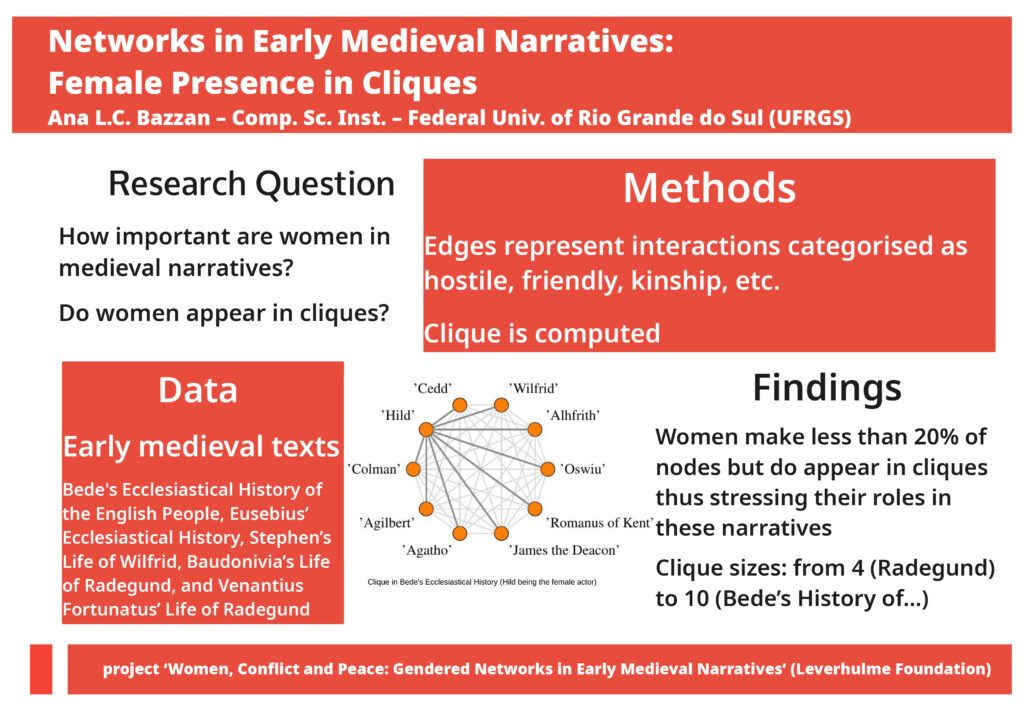Ana Bazzan
Place and Time: Thursday, 01.07., 16:00–17:00, Room 4
Session: Poster Session – Networks and Medieval Texts
Background
Techniques stemming from the theory of social networks are increasingly being used as quantitative tools with which one may analyse and quantify interpersonal relationships. In particular, historians are employing them aiming at gaining new insights in several case studies (Gould, 2003; Gramsch, 2014; Dahmen et al., 2017).
A social network or a graph G is formally defined as G = (N, L), where N is the set of nodes (the actors in the network), and L is the set of links. A link is a connection (or interaction) of any sort between two nodes. There are many measures that characterize the structure of a network. In particular, we are interested here in the clique.
Methods and Data
For the experiments reported in this work, we use several early medieval texts in which the role of women as connectors is being investigated within the project ‘Women, Conflict and Peace: Gendered Networks in Early Medieval Narratives’. Among them, we men tion Bede’s Ecclesiastical History of the English People, Eusebius’ Ecclesiastical History, Stephen’s Life of Wilfrid, Baudonivia’s Life of Radegund, and Venantius Fortunatus’ Life of Radegund.
Interactions between two nodes are classified in 21 categories (which were de vised by the historians experts). Without extensively listing all of these, it suffices to mention that some refer to hostile interactions (e.g., military hostility), some to family in teractions (e.g., marriage), and some to friendly ones (e.g., patronage). Henceforth these three groups of categories are refers as hostile, family, and friendly interactions.
In the present work, we compute the clique, which is the subset of nodes, in which any two nodes in the clique are directly connected. We do this for each text source (as far as this is possible) and also for the three respective aforementioned groups of interactions. We show their sizes (how many nodes participate in each clique) as well as list the names of women that are part of each clique.
Findings
Results show that cliques are not large; they involve a small number of nodes, but some do contain women, which is a positive result given that this means that such women are connected to other actors in the clique, as depicted in Figure 1 for instance. Sizes of cliques range from 4 (Radegund) to 10 (Bede’s History of. . . ). It must be noted that, due to the size of the respective networks, the clique in Eusebius’ Life of Constantine and Eusebius’ Ecclesiastical History could not be calculated. For this reason, the network was broken down by groups of categories. The clique for the hostile categories is 3 for both texts. For the domestic categories, it is 4 (Ecclesiastical History) and 5 (Life of Constantine).
As a general conclusion, we can state that women, despite making less than 20% of the totality of nodes (except for the texts on Radegund) do appear in cliques, even in the largest one (Bede’s History of. . . ), thus stressing their roles in these narratives.
References
Dahmen, S. R., A. Bazzan, and R. Gramsch (2017, March). Community detection in the network of German princes in 1225. In B. Gonçalves, R. Menezes, R. Sinatra, and V. Zlatic (Eds.), Complex Networks VIII: Proceedings of the 8th Conference on Complex Networks (CompleNet 2017), pp. 193–200. Springer.
Gould, R. V. (2003). USES OF NETWORK TOOLS IN COMPARATIVE HISTORICAL RESEARCH, pp. 241—-269. Cambridge Studies in Comparative Politics. Cambridge: Cambridge University Press.
Gramsch, R. (2014). Conflicts as a structure-forming force: The reign of Henry (VII) (1225-1235) in network-analytic perspective. In Multiplying Middle Ages. New meth ods and approaches for the study of the multiplicity of the Middle Ages in a global perspective (3rd–16th CE). (pre print).

